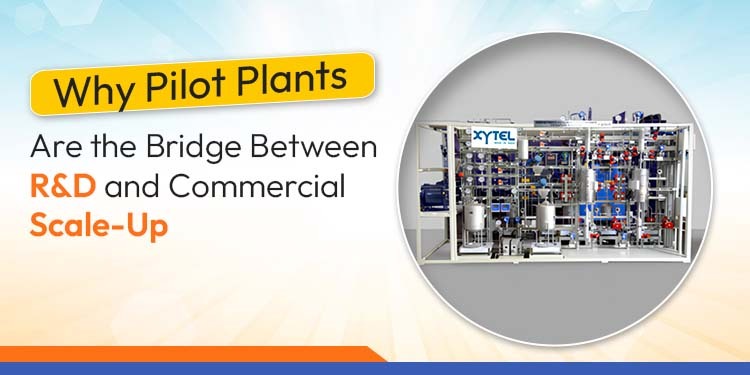Premier Pilot Plant People

Why Pilot Plants Are the Bridge Between R&D and Commercial Scale-Up
Why Pilot Plants Are the Bridge Between R&D and Commercial Scale-Up
Moving a new process from the lab bench to full-scale production isn’t just a matter of scaling equipment; it’s about scaling knowledge, reliability, and economics. Between the controlled precision of R&D and the demanding realities of manufacturing lies the most critical stage of all: the pilot plant. A well-designed pilot plant doesn’t just test a process; it transforms potential into proven performance. It’s the bridge between scientific innovation and commercial viability.1. The Role of a Pilot Plant in Process Development
Every process development journey follows three stages:- Laboratory Scale – Concept validation and chemistry understanding.
- Pilot Scale – Process proof under near-industrial conditions.
- Commercial Scale – Full-capacity production with validated parameters.
2. Why Pilot Plants Are Indispensable in Scale-Up
a. Reducing Scale-Up Risk
Processes that run perfectly in a beaker can behave very differently in a 5,000-liter reactor. Changes in surface-to-volume ratios, mixing dynamics, and heat transfer characteristics can alter reaction efficiency, yield, and safety. Pilot plants allow engineers to simulate these conditions, exposing hidden issues such as inadequate cooling, uneven mixing, or solids build-up, all before committing to multimillion-dollar commercial equipment.b. Validating Process Reliability
Beyond technical success, repeatability is the true test of a scalable process. The pilot phase enables validation of process consistency, instrumentation accuracy, and operator procedures. It’s where the critical process parameters (CPPs) and critical quality attributes (CQAs) are locked down, the same ones that define product reliability at commercial scale.c. Building a Strong Business Case
Pilot operations generate hard data, consumption rates, yields, utility usage, and downtime that feed into accurate cost models. This allows management to judge whether a process is economically viable, not just chemically possible. When pilot results confirm favorable economics, capital allocation for the commercial plant becomes a confident decision rather than a leap of faith.d. Facilitating Technology Transfer
Transitioning a process from R&D to production requires more than design drawings. It requires knowledge transfer, the detailed operating conditions, safety limits, cleaning procedures, and control logic. A pilot plant provides the common ground where R&D scientists, process engineers, and plant operators collaborate. This ensures that the full-scale implementation starts from experience, not assumptions.3. Technical Parameters That Define Scale-Up Success
A successful pilot plant design mirrors the behavior of the intended full-scale process as closely as possible. Engineers typically consider several scaling criteria and dimensionless numbers to maintain similarity and predict performance.1. Geometric and Dynamic Similarity
Scaling involves maintaining critical ratios such as:- Reynolds number for flow and mixing dynamics.
- Froude number for impeller and agitation behavior.
- Peclet number for heat and mass transfer balance.
2. Heat and Mass Transfer Efficiency
At larger scales, the surface-to-volume ratio decreases, making temperature control more challenging. Poor heat transfer can lead to hotspots, uneven reactions, or incomplete conversions. Pilot-scale testing ensures proper thermal management systems are built into the commercial design.3. Material Handling and Equipment Configuration
Feeding, conveying, and mixing bulk materials pose challenges unseen at lab scale. Solids may bridge, slurry viscosity may increase, or gas dispersion may fall off. Pilot trials reveal such practical issues early, allowing engineers to modify agitator design, baffle placement, or feed systems.4. Instrumentation and Automation
Manual controls used in R&D are replaced with automated systems at scale. The pilot stage validates control loops, safety interlocks, and alarm logic to ensure process stability and compliance with operational standards.5. Safety and Environmental Controls
A pilot environment enables realistic evaluation of safety interlocks, pressure relief systems, and waste handling processes, ensuring that full-scale operations meet regulatory and environmental obligations.4. The Pilot Phase as a Strategic Decision Gate
Pilot plants serve as a decision checkpoint before full-scale investment. By this stage, the data collected should answer:- Are yields consistent and reproducible?
- Is the process safe and controllable?
- What are the actual operating costs?
- Are there any bottlenecks or waste streams to optimize?
- Can this process meet market demand sustainably?
5. Designing the Pilot Plant for Success
The success of a pilot program depends heavily on thoughtful design. A well-engineered pilot plant must balance flexibility, scalability, and safety. Key design principles include:- Modular layouts for easy reconfiguration of unit operations.
- Compact skid-mounted systems for mobility and faster installation.
- Integrated automation for data collection and remote monitoring.
- Scalable utilities to replicate real production conditions.
- Built-in provisions for cleaning, maintenance, and operator safety.
6. The Payoff: Bridging Innovation and Industry
A strong pilot plant strategy does more than validate chemistry; it drives business continuity and innovation. It allows teams to:- Shorten development cycles.
- Reduce capital risk.
- Improve process understanding.
- Strengthen collaboration between R&D, engineering, and operations.
- Accelerate time-to-market for new technologies.
Get in Touch
You will be amazed as how partnering with us becomes a game changer in your quest for R&D glory.

 Call Us
Call Us